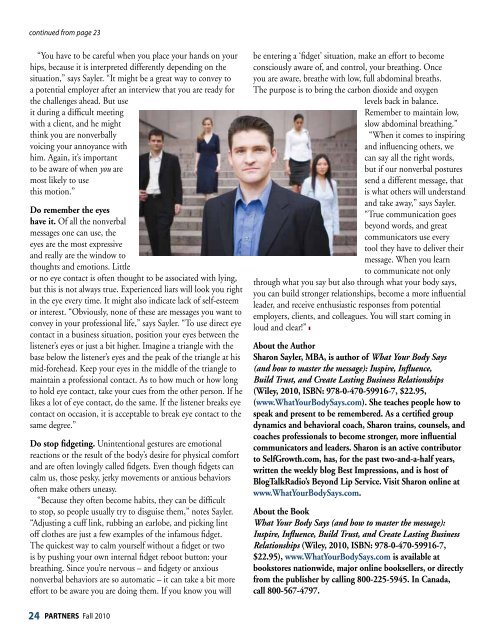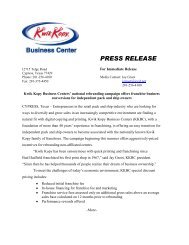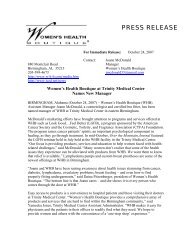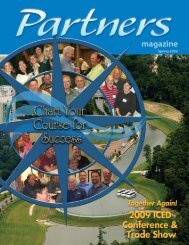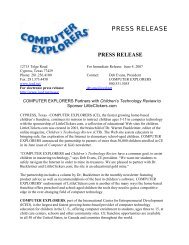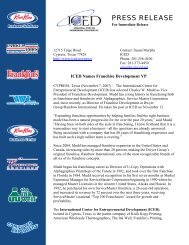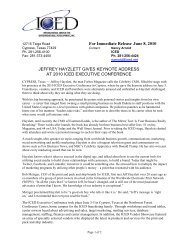Position Your Company for a Business Loan Using Facebook as a ...
Position Your Company for a Business Loan Using Facebook as a ...
Position Your Company for a Business Loan Using Facebook as a ...
You also want an ePaper? Increase the reach of your titles
YUMPU automatically turns print PDFs into web optimized ePapers that Google loves.
continued from page 23<br />
“You have to be careful when you place your hands on your<br />
hips, because it is interpreted differently depending on the<br />
situation,” says Sayler. “It might be a great way to convey to<br />
a potential employer after an interview that you are ready <strong>for</strong><br />
the challenges ahead. But use<br />
it during a difficult meeting<br />
with a client, and he might<br />
think you are nonverbally<br />
voicing your annoyance with<br />
him. Again, it’s important<br />
to be aware of when you are<br />
most likely to use<br />
this motion.”<br />
Do remember the eyes<br />
have it. Of all the nonverbal<br />
messages one can use, the<br />
eyes are the most expressive<br />
and really are the window to<br />
thoughts and emotions. Little<br />
or no eye contact is often thought to be <strong>as</strong>sociated with lying,<br />
but this is not always true. Experienced liars will look you right<br />
in the eye every time. It might also indicate lack of self-esteem<br />
or interest. “Obviously, none of these are messages you want to<br />
convey in your professional life,” says Sayler. “To use direct eye<br />
contact in a business situation, position your eyes between the<br />
listener’s eyes or just a bit higher. Imagine a triangle with the<br />
b<strong>as</strong>e below the listener’s eyes and the peak of the triangle at his<br />
mid-<strong>for</strong>ehead. Keep your eyes in the middle of the triangle to<br />
maintain a professional contact. As to how much or how long<br />
to hold eye contact, take your cues from the other person. If he<br />
likes a lot of eye contact, do the same. If the listener breaks eye<br />
contact on occ<strong>as</strong>ion, it is acceptable to break eye contact to the<br />
same degree.”<br />
Do stop fidgeting. Unintentional gestures are emotional<br />
reactions or the result of the body’s desire <strong>for</strong> physical com<strong>for</strong>t<br />
and are often lovingly called fidgets. Even though fidgets can<br />
calm us, those pesky, jerky movements or anxious behaviors<br />
often make others une<strong>as</strong>y.<br />
“Because they often become habits, they can be difficult<br />
to stop, so people usually try to disguise them,” notes Sayler.<br />
“Adjusting a cuff link, rubbing an earlobe, and picking lint<br />
off clothes are just a few examples of the infamous fidget.<br />
The quickest way to calm yourself without a fidget or two<br />
is by pushing your own internal fidget reboot button: your<br />
breathing. Since you’re nervous – and fidgety or anxious<br />
nonverbal behaviors are so automatic – it can take a bit more<br />
ef<strong>for</strong>t to be aware you are doing them. If you know you will<br />
24 PARTNERS Fall 2010<br />
be entering a ‘fidget’ situation, make an ef<strong>for</strong>t to become<br />
consciously aware of, and control, your breathing. Once<br />
you are aware, breathe with low, full abdominal breaths.<br />
The purpose is to bring the carbon dioxide and oxygen<br />
levels back in balance.<br />
Remember to maintain low,<br />
slow abdominal breathing.”<br />
“When it comes to inspiring<br />
and influencing others, we<br />
can say all the right words,<br />
but if our nonverbal postures<br />
send a different message, that<br />
is what others will understand<br />
and take away,” says Sayler.<br />
“True communication goes<br />
beyond words, and great<br />
communicators use every<br />
tool they have to deliver their<br />
message. When you learn<br />
to communicate not only<br />
through what you say but also through what your body says,<br />
you can build stronger relationships, become a more influential<br />
leader, and receive enthusi<strong>as</strong>tic responses from potential<br />
employers, clients, and colleagues. You will start coming in<br />
loud and clear!” z<br />
About the Author<br />
Sharon Sayler, MBA, is author of What <strong>Your</strong> Body Says<br />
(and how to m<strong>as</strong>ter the message): Inspire, Influence,<br />
Build Trust, and Create L<strong>as</strong>ting <strong>Business</strong> Relationships<br />
(Wiley, 2010, ISBN: 978-0-470-59916-7, $22.95,<br />
(www.What<strong>Your</strong>BodySays.com). She teaches people how to<br />
speak and present to be remembered. As a certified group<br />
dynamics and behavioral coach, Sharon trains, counsels, and<br />
coaches professionals to become stronger, more influential<br />
communicators and leaders. Sharon is an active contributor<br />
to SelfGrowth.com, h<strong>as</strong>, <strong>for</strong> the p<strong>as</strong>t two-and-a-half years,<br />
written the weekly blog Best Impressions, and is host of<br />
BlogTalkRadio’s Beyond Lip Service. Visit Sharon online at<br />
www.What<strong>Your</strong>BodySays.com.<br />
About the Book<br />
What <strong>Your</strong> Body Says (and how to m<strong>as</strong>ter the message):<br />
Inspire, Influence, Build Trust, and Create L<strong>as</strong>ting <strong>Business</strong><br />
Relationships (Wiley, 2010, ISBN: 978-0-470-59916-7,<br />
$22.95), www.What<strong>Your</strong>BodySays.com is available at<br />
bookstores nationwide, major online booksellers, or directly<br />
from the publisher by calling 800-225-5945. In Canada,<br />
call 800-567-4797.


